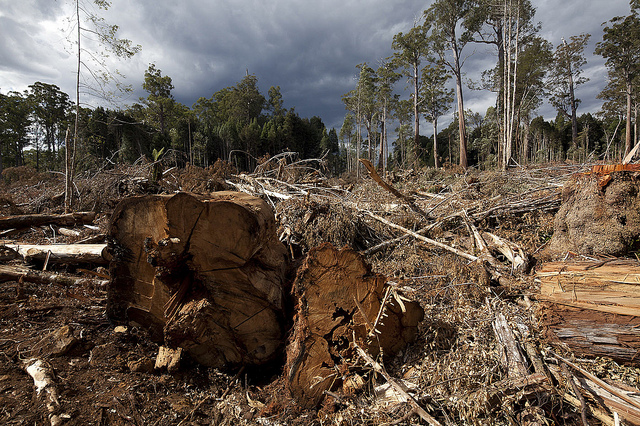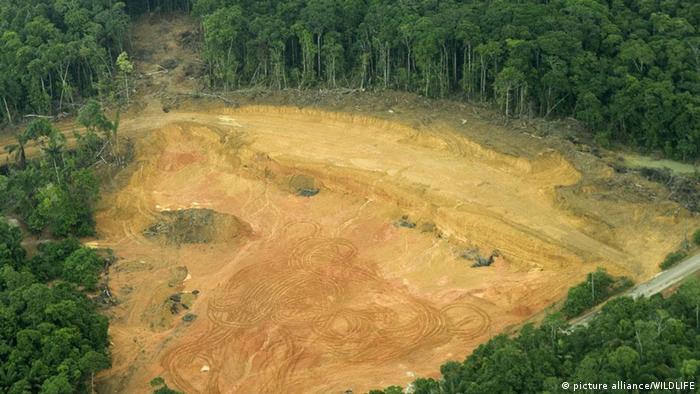Search Results for Tag: forest
For what we risk biodiversity (2): Toilet paper
Author: Kerstin Schnatz
The tallest hardwood trees on earth are towering 90 meters and more in height in Tasmania. The island state 240 km South of the Australian mainland is not just famous with hikers and nature lovers – it also has a very strong timber industry. Now the Australian government wants to open more forest sites for potential logging.

Picture from February 2012: A logging site close to the Tasmanian Wilderness World Heritage Area.
(Photo credit: CC BY NC SA 2.0: Ta Ann Truths)
Almost 50% of Tasmania’s land area is protected for a good reason: The ancient forests give a habitat to many threatened species such as the almost extinct Tasmanian devil or the endangered Tasmanian wedge-tailed eagle.
Now the worst nightmare of Australian environmental activists has come true: Their government has put in a pledge to the United Nations to remove 74.000 hectares of Tasmanian forest from world heritage listing. The very land had only been protected in 2012 within a larger area of 174,000 hectares, ending a decades long conflict between the timber industry and environmental groups. The reason? The relativele new Australian government that had been elected in 2013 finds the area not so special after all. Government speakers reckon that much of the area had been logged already anyway and should not have been considered for protection in the first place.
Naturally, environmental groups think of this otherwise stating that almost 93% of the area in question consists of precious old growth forests. They fear, that their government wants to open the doors for the Tasmanian timber industry – one of the most thriving branches of the tiny state’s economy.
Large international companies such as Malaysian owned veneer manufacturer Ta Ann have wood manufacturing mills in Tasmania. Many of those mills produce woodchips used for making writing paper, tissues or even toilet paper.
To proof how precious and needy of protection Tasmania’s forest are, the Wilderness Society released pictures of the area in question.
Harsher images paints the Tasmanian Leader of the Green party with his words stating in a television report by the national TV channel ABC : “Logging in a world heritage area is akin to the Taliban dynamiting millenia old religious statues.”
We all agree, that nature’s richness is precious and needs to be protected. But at the same time it sometimes “just happens” that this precious biodiversity is set at risk. To raise awareness for this contradiction, we started this little blog series, featuring examples of this phenomenon. See part 1 here. If you know similar examples, that fit into this series, please drop us a line in the comment box below.
On location in Rwanda: towering trees and crazy discussions
Modern skyscrapers and people talking to towering trees, irrepressible children who insisted on being in every frame and a heated discussion during a drive – reporter Julia Henrichmann came away with some lasting impressions while filming in Rwanda.
It doesn’t matter where you are in the Rwandan capital Kigali, chances are you’ll always find a moto-taxi (a motorcycle taxi), at your side waiting to drive you through the lush green valleys dotting the city. On the one hand, Kigali is a modern city with skyscrapers, busy streets and crowded shops. On the other, it’s also not unusual to come across pockets where some of the most amazingly large trees and plants find space to grow.
To get a sense of how big the trees are, I asked our driver Ismael to stand next to one I liked very much. He suddenly touched the tree and began talking to it. I asked him why. “Oh,” he said. “This must be a very old one, much older than me so I have to treat it with respect.”
I cannot say whether people are as respectful of nature everywhere in the country. There are many areas in Rwanda where people cut almost every tree for firewood. Gathering firewood is normally done by children. Some don’t go to school because of the long distances they have to walk to get firewood. It’s a problem that’s worsening by some estimates. Firewood is used in homes for cooking because there’s often no electricity. Many use diesel generators.
When we came to the countryside to the district of Nasho, many children wanted to touch me. Most of them had never seen a white person because they had never traveled beyond their district. They were delightful and innocent in a way that I have never seen children elsewhere. Maybe that’s because they did not expect anything from me. All they wanted was that I listen to them and spend some time with them (even though I did not understand their language).
And, of course they wanted me to take photos with them, even during the filming. They walked into every frame! How could we tell them that we just wanted Anastase Tabaro in the film, the man who brought electricity to their village? So we decided to make them part of the film. The villagers’ happiness and pride was palpable as they led us to the little hydro-electrical pump Anastase Tabaro had built for them.
Driving back to Kigali, we had a crazy animated discussion in the car and I became a bit alarmed that the Rwandans would come to blows. So they stopped talking in their native language and switched to English and French for my benefit. And so, what was the big discussion about? What’s the topic that pops up in conversations in Rwanda sooner or later? The genocide.
Even though it happened almost 20 years ago, everybody still talks very much talks about it. Every family here has been affected personally by the tragic event. When you come to Rwanda, you should no longer ask: “Are you a Hutu or a Tutsi?” That’s not the question anymore. The question we argued about in the car was the role of the media during the war and the genocide. Do you as a camera crew film or do you help the victims lying at your feet? During the three-hour drive, we came no closer to any answers. You will probably never find them.
New brazilian land law softens environmental regulations, WWF alarmed
 The Brazilian parliament has adopted a new, hotly-debated land law. Environmentalist fear that it puts the country’s rainforest, one of the world’s richest, at high risk.
The Brazilian parliament has adopted a new, hotly-debated land law. Environmentalist fear that it puts the country’s rainforest, one of the world’s richest, at high risk.
Large landowners and peasants benefit from the law, because it eases existing restrictions: landowners are no longer bound to reforest riverbanks, for example, and environmental regulations have also been softened.
![]() read more
read more
“The Man Who Planted Trees”

It all started way back in 1979, according to the Times of India . That year, a huge flood washed a lot of snakes ashore on a sandbar. 16-year-old Payeng went there, the day the waters had receded. He found the snakes dead, and that experience changed his live. “The snakes died in the heat, without any tree cover,” he said to the newspaper. When he tried to ask the forest department to plant trees there, he made little headway. Nothing would grow there, the department answered. He should try growing bamboo on the sandbank instead, they told him. So that’s what he did.
Forestry officials in the region first learned of this new forest in 2008. Since then, they’ve come to recognize Payeng’s efforts as truly remarkable. “We’re amazed at Payeng,” says Assistant Conservator of Forests, Gunin Saikia. “Had he been in any other country, he would have been made a hero.”
Brazil’s new forest law
 As the world tries to find ways the reduce global emission in Durban, Eco, a publication of Climate Action Network CAN at COP17, is reporting on Brazils plans of igniting a real carbon bomb. A bill to change the country’s Forest Law is supposedly about to be approved, resulting in the increase of deforestation. The proposed bill, they say, will be sent to President Dilma Roussef for final cinsideration in coming weeks. One of the foreseeable consequences is that an area almost the size of France and Great Britain combined will loose legal protection, according to estimates presented by the Brazilian government itself. Since Brazil will be hosting the Rio+20 con fence next year, the situation is even more delicate.
As the world tries to find ways the reduce global emission in Durban, Eco, a publication of Climate Action Network CAN at COP17, is reporting on Brazils plans of igniting a real carbon bomb. A bill to change the country’s Forest Law is supposedly about to be approved, resulting in the increase of deforestation. The proposed bill, they say, will be sent to President Dilma Roussef for final cinsideration in coming weeks. One of the foreseeable consequences is that an area almost the size of France and Great Britain combined will loose legal protection, according to estimates presented by the Brazilian government itself. Since Brazil will be hosting the Rio+20 con fence next year, the situation is even more delicate.
In the corridors at Durban, these developments are causing considerable consternation. It is expected that Brazil President Dilma Roussef will send a clear message to the world that the country will meet all commitments announced previously in fighting climate change and protecting the Brazil forest.












Feedback